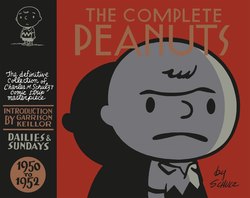Отрывок из книги
Sparky Schulz (b. 11/26/22) was a shy, self-conscious kid with bad skin, too light to play football, not tall enough for basketball, the only child of Carl and Dena Schulz of St. Paul, a painful student at St. Paul Central High School, failing at everything, wanting to talk to girls and not knowing how, tormented by teachers and other bullies, finding solace at the movies, sitting in the lovely dark and watching Victor McLaglen in Lost Patrol and Gary Cooper in Beau Geste and Laurel and Hardy and Tarzan, and reading the funny papers, Popeye and Captain Easy and Wash Tubbs. Hundreds of other St. Paul boys were in the same boat, whether Sparky knew it or not, and negotiated the white waters of adolescence and came out into the calm pond of Actuarial or Home Loans or Homiletics, but Sparky had a good hand for drawing with a pencil, at least compared to other kids at Central High he did, and when his mom saw an ad for a University of Minnesota extension class in cartooning, he enrolled in it, and that, as they say, was that. The boy got a notion that he had a Gift and found an endeavor that quickened his heart and might be his Calling and this miraculous turn of events steadied him through the travails of the Nineteen Forties. He was drafted by the Army in 1943, about the time his mom was diagnosed with cancer. She looked up at him from her bed and said, “I suppose that we should say goodbye” and died the next day. After training at Camp Campbell, Kentucky, he shipped off to Europe with the infantry, the leader of a machine gun squad, a serious soldier, and put aside cartooning until he returned home. He hung around St. Paul for a few years, taught at the commercial art correspondence school in Minneapolis where he had formerly been a student, got good at cartoon lettering, sold some gag cartoons to The Saturday Evening Post, and then, encouraged by a fellow instructor named Frank Wing, focused on drawing little kids and created a strip cartoon called Li’l Folks which he sold to the St. Paul Pioneer Press which ran it in the women’s section. It was an odd strip, no adults present, only kids, who were not little rascals like the Katzenjammers or Little Iodine, but contemplative creatures capable of long brooding thoughts and comic pathos. He drew the strip for two years for $10 a week and then went in to the paper and asked for a raise and for a better ocation in the paper and was turned down. “Then I better quit,” said Sparky. “All right,” said the editor. That was in the spring of 1950. Schulz was 27. He got on the train to New York and took his strip to Jim Freeman, the editorial director of United Feature Syndicate, who snapped it up and the first Peanuts strip appeared on October 2, 1950. And that is the St. Paul chapter of the legend of Charles Schulz. Good grief.
We St. Paulites wish we could make it up to Sparky and since his death the city has gone through waves of Peanuts sculptures, polyurethane Charlie Browns and Lucys and Linuses and Snoopys, hanging out in Rice Park and on Selby Avenue near Sparky’s dad’s old barbershop and all over town. We’d give anything if we could go back to 1950 and say the right thing and not drive him away to Santa Rosa, California. I would mention in my city’s defense that Sparky took up golf here and that gave him pleasure and he became active in the Church of God and found a spiritual home there. He became a serious reader here after the war, riding the streetcar back and forth to his job in downtown Minneapolis, reading Tolstoy and Thomas Wolfe and Fitzgerald, and he loved his time at the correspondence school. So he did find a degree of happiness here. We weren’t a gulag in his life. He learned a lot about pen technique here that helped him get Linus’s hair right and the zigzags on Charlie Brown’s sweater and Snoopy sitting on the doghouse writing on the typewriter. And Peanuts is more about St. Paul than it is about Santa Rosa, I’d say. Snow falls on Snoopy’s doghouse. The beautiful modesty and understatement of the strip strike us as Midwestern. Charlie Brown is a stoic like us. He doesn’t imagine that some magical book or herb or 12-step program is going to turn him into Charles Green. And it’s the Great Pumpkin who comes at Halloween, not the Blissful Artichoke or the Sacred Asparagus.
.....
Feiffer, the melancholy Jewish intellectual striking at the heart of life as we knew it, saw in Schulz a fellow subversive. Their styles and audience could not have been more different. Feiffer aimed for an elite, urban audience; Schulz was drawing for everyone everywhere. But their territory overlapped. In a Feiffer cartoon of the late ’50s, a teenager enumerates the horror of middle age: getting stuck in a marriage, living in the suburbs, dying of boredom. A man confronts the teenager: “Why don’t you just grow up?” The teenager replies: “For our generation a refusal to grow up is a sign of maturity.” That was the message of Peanuts, too. Schulz was drawing the “inner child” many years before the concept emerged in the popular culture.
The Peanuts gang was appealing but also strange. Were they children or adults? Or some kind of hybrid? What would push real children to the breaking point, Charlie Brown handled admirably and without self-pity or self-congratulation. What would reduce children to tears in the real world was routinely endured in Peanuts.
.....
